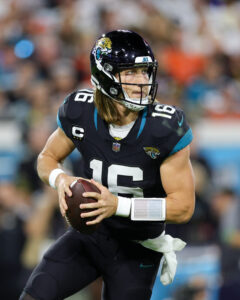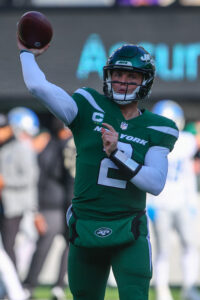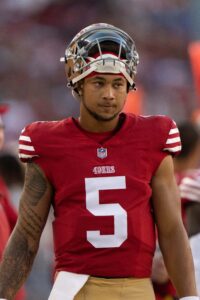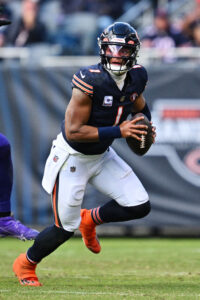With the 2024 draft approaching, this year’s crop of quarterbacks will increasingly become the center of attention around the NFL. Acquiring rookie passers is viewed as the surest route to long-term success, and the urgency teams feel to generate quick rebuilds fuels aggressive moves aimed at acquiring signal-callers deemed to have high upside.
Each class is different, though, and past drafts can offer a cautionary tale about the downfalls of being overly optimistic regarding a young quarterback. In the case of the 2021 draft, five signal-callers were selected on Day 1, and to varying extents things have not gone according to plan in each case. Three quarterbacks (quite possibly four, depending on how the immediate future plays out) have been traded, while the other has not lived up to expectations.
Here is a breakdown of all five QBs taken in the first round three years ago:
Trevor Lawrence (No. 1 overall, Jaguars)
Lawrence entered the league with enormous expectations after his high school and college success, having been touted as a generational prospect. The Clemson product (like the rest of the Jaguars) endured a forgettable season under head coach Urban Meyer as a rookie, however. The latter’s firing paved the way for the arrival of Doug Pederson, known to be a QB-friendly coach. Lawrence improved in 2022, earning a Pro Bowl nod and helping guide the team to the divisional round of the postseason. 
This past campaign saw the 24-year-old battle multiple nagging injuries, and he was forced to miss a game for the first time in his career. Jacksonville failed to find a rhythm on offense throughout the year, and a late-season slump left the team out of the playoffs altogether after a division title seemed to be in hand. In two seasons under Pederson, Lawrence has totaled 46 touchdown passes and 22 interceptions – figures which fall short of what the pair were thought to be capable of while working together. Nonetheless, no changes under center will be forthcoming.
Following in line with his previous stance on the matter, general manager Trent Baalke confirmed last month extension talks with Lawrence have begun. The former college national champion will be on his rookie contract through 2025 once the Jaguars exercise his fifth-year option, but megadeals finalized in a QB’s first year of extension eligibility have become commonplace around the NFL. Lawrence profiles as Jacksonville’s answer under center for years to come, something of particular significance given the team’s past struggles to find a long-term producer at the position.
Four young passers inked second contracts averaging between $51MM and $55MM per year last offseason. Lawrence is positioned to be the next in line for a similar deal, though his generally pedestrian stats could hinder his leverage to a degree. At a minimum, he will see an AAV much higher than that of his 2025 option ($25.66MM) once his next contract is in place.
Zach Wilson (No. 2, Jets)
 The Jets’ decision to take Sam Darnold third overall in 2018 did not prove fruitful, and in short order the team was in need of another young passer. Wilson was immediately installed as the team’s starter, but in both his rookie campaign and his follow-up season he struggled in a number of categories. A lack of improvement regarding accuracy and interception rates made it clear a more proven commodity would be required for a team internally viewed as being a quarterback away from contention.
The Jets’ decision to take Sam Darnold third overall in 2018 did not prove fruitful, and in short order the team was in need of another young passer. Wilson was immediately installed as the team’s starter, but in both his rookie campaign and his follow-up season he struggled in a number of categories. A lack of improvement regarding accuracy and interception rates made it clear a more proven commodity would be required for a team internally viewed as being a quarterback away from contention.
That drove the decision to trade for Aaron Rodgers last offseason, a move aimed at relying on the future Hall of Famer in the short term while allowing Wilson to develop as a backup. Four snaps into the season, though, Rodgers’ Achilles tear upended that plan and thrust Wilson back into a starting role. Playing behind a struggling (and injury-marred) offensive line, the BYU alum guided an offense which finished 29th in scoring and 31st in yardage. In the wake of the poor showing, owner Woody Johnson publicly disparaged Wilson in vowing to upgrade the QB2 spot.
With Tyrod Taylor now in place (and Rodgers aiming to continue playing into his 40s), Wilson’s New York days are believed to be numbered. The Jets have given him permission to seek a trade, which comes as little surprise given the team’s decision to bench him on a few occasions over the past two seasons. A fresh start for both parties could be beneficial, although value on a deal will come well short of the capital used to draft him. Offers for the 24-year-old have nevertheless been received, so a deal could be struck in relatively short order.
Once that takes place, New York will have once again cut bait with a failed QB project. Wilson could follow Darnold’s path in taking on a backup gig before receiving another starting opportunity with a new team. For the time being, though, he will aim to find the ideal supporting role in an attempt to rebuild his value.
Trey Lance (No. 3, 49ers)
Aggressively pursuing a Jimmy Garoppolo upgrade, San Francisco moved up the board at a substantial cost. The 49ers sent the Dolphins a package including three first-round picks and a third-rounder, banking on Lance’s athletic upside. After a year sitting behind Garoppolo, the North Dakota State product was positioned to take over in 2022. 
However, a Week 2 ankle fracture cut Lance’s season was cut short; this proved to mark an end to his San Francisco tenure. In all, Lance made just four regular-season starts with the 49ers, as the 2022 season unintentionally resulted in Brock Purdy taking over the starter’s role. The emergence of the former Mr. Irrelevant paved the way for Lance to be traded, but his injury history and inconsistent play when on the field limited his trade market. The Cowboys won a brief bidding war, acquiring Lance for a fourth-round pick.
Lance did not see the field in his first season as a Cowboy, but Dallas will keep him in the fold for the 2024 campaign. He will thus be in line to serve as Dak Prescott’s backup for a year; the latter is not under contract for 2025, but he remains firmly in the team’s plans. Unless Prescott were to depart in free agency next offseason, a path to a No. 1 role does not currently exist for Lance.
The 23-year-old could nevertheless still be viewed as a worthwhile developmental prospect given his age and athletic traits. The Lance acquisition has clearly proven to be a mistake on the 49ers’ part, though, especially given the success the team has had without him. What-ifs will remain a part of this 49ers chapter’s legacy (particularly if the current core cannot get over the Super Bowl hump) considering the substantial price paid to move up the board and the draft picks not available in subsequent years as a result.
Justin Fields (No. 11, Bears)
 Like San Francisco, Chicago did not wait on the chance of having a top QB prospect fall down the draft board. The Bears moved two first-round picks, along fourth- and fifth-rounders, to move ahead of the Patriots and add a presumed long-term answer under center. Fields saw playing time early enough (10 starts as a rookie), but his performance that year left plenty of room for improvement.
Like San Francisco, Chicago did not wait on the chance of having a top QB prospect fall down the draft board. The Bears moved two first-round picks, along fourth- and fifth-rounders, to move ahead of the Patriots and add a presumed long-term answer under center. Fields saw playing time early enough (10 starts as a rookie), but his performance that year left plenty of room for improvement.
A head coaching change from Matt Nagy to Matt Eberflus also brought about the arrival of a new offensive coordinator (Luke Getsy). Fields did not make the expected jump as a passer in the new system, averaging less than 150 yards per game through the air and taking 55 sacks. He became only the third quarterback to record over 1,000 yards on the ground in a season, though, showcasing his rushing ability. The Ohio State product made only incremental progress in 2023, despite an improved offensive line and the trade acquisition of wideout D.J. Moore.
As a result, speculation steadily intensified that general manager Ryan Poles – who was not a member of the regime which drafted Fields – would move on from the 25-year-old. Fields received endorsements from Eberflus, Poles and others in the building, but the team decided to move on and pave the way for (in all likelihood) Caleb Williams being drafted first overall. A conditional sixth-round pick sent Fields to the Steelers, his preferred destination.
In Pittsburgh, Fields is slated to begin as the backup Russell Wilson. Both passers face uncertain futures beyond 2024, especially with the former not on track to have his fifth-year option exercised. Fields could play his way into the starter’s role in relatively short order given the 10-year age gap between he and Wilson, who flamed out in Denver. That, in turn, could see his market value jump higher than that of the other non-Lawrence members of this class given their respective situations.
Mac Jones (No. 15, Patriots)
Drafted to become the Tom Brady successor of both the short- and long-term future, Jones was immediately installed as New England’s starter. Coming off a national title with Alabama, he appeared to set the stage for a long Patriots tenure by earning a Pro Bowl nod and finishing second in Offensive Rookie of the Year voting. Nothing went according to plan for team or player beyond that point, however. 
Jones saw Josh McDaniels depart in the 2022 offseason, leaving head coach Bill Belichick to hand the offensive reins over to Matt Patricia and Joe Judge. That move resulted in widespread struggles on offense, and Jones regressed. Following a 2021 playoff berth, the inability to venture back to the postseason the following year led to increased speculation about the team’s future under center. That became particularly true amid reports of tension between Jones and Belichick.
With both coach and quarterback under pressure to rebound, optimism emerged when the Patriots hired Bill O’Brien as OC. That move did not produce the desired results, though, and by the end of the year Jones was benched in favor of Bailey Zappe. With a Belichick-less regime set to start over at the quarterback spot, the former was dealt to the Jaguars for a sixth-round pick.
Jones has publicly stated the deal (which sent him to his hometown team) was a mutual parting of ways. A backup gig behind Lawrence could allow the pocket passer to regain some of his confidence generated by his rookie success, but his showings over the past two seasons will no doubt give teams considerable pause with respect to viewing him as a starter down the road. Jones’ athletic profile is also a less favorable one than that of Wilson, Lance and especially Fields, something which could further consign him to QB2 duties for the foreseeable future.
Four quarterbacks are considered locks to hear their names called on Day 1 of the 2024 draft, one in which each of the top three picks may very well once again be used on signal-callers. Other QB prospects are also in contention for Round 1 consideration, meaning they and their new teams will be subject to considerable scrutiny. To put it lightly, all parties involved will hope the top of this year’s class pans out better than that of its 2021 counterpart.

that draft class was thought to be loaded – and turned out to be very underwhelming
Clearly. Except this years class is simply better. The only thing that will kill them is going to the wrong teams. Fields to the Patriots would have been much better. His rushing ability with that defense would have been tough. Mac Jones was doomed to fail the moment Matt Patricia went anywhere near him. Facts. Fatty Patty spells doom for everyone he is around. Zack Wilson will do fine anywhere else and dude from the Niners got hurt. We have no idea if he is or is not good.
These 5 Guys should all be making burgers and fries.
Right. Trevor Lawrence should be making Burgers while you do what again? Are you the fry guy?
“Dandy” lol
It’s that urgency teams feel to generate quick rebuilds that dooms a lot of these QB prospects.
agreed, just look at the formula the packers use with their qb’s. 2 h.o.f. and a promising looking kid all back to back
Back in the day teams would get the supporting pieces in place and then add the QB so he would at least have a chance to succeed but now the approach is the reverse.
That draft will go down as a cautionary tale for perceived QB-heavy drafts in the future.Or not.
Like this year’s class?
This year’s QB draft is marginal with a whole bunch of Zach Wilson/Mac Jones type talents. It could be worse (2022, the year of Pickett and Howell) but it’s not good. Any team who trades to the top of the first round will be very sorry. Imagine how deep the 49ers roster would be now with three first round draft picks on the roster and a third.
This was one loaded QB draft class that ended up being cringeworthy every spot you scroll downward.
I think Lawrence will be ok. Maybe not elite, but he’ll bounce back and have a decent 2024 and get an extension from Jax.
The other 4….busts. Only question is which one is the biggest one? I’d say Wilson. He was handed the starting job twice and lost it and didn’t look good doing it.
So true. There was once a time when QBs weren’t going to see the field in their first year or two, even if they were the future. Normally, many of them eventually worked out. Today the expectations are unrealistic and their youth and pressure creates bad habits and forced play.
As a Pats fan, Mac got a raw deal. A different OC every year, one of those being Patricia. Absolutely no offensive talent around him. A promising rookie season was quickly erased. He was pretty bad the last two years. I truly believe he can be a serviceable starter somewhere.
Don’t forget Bill is a terrible GM/scout. Bill is overrated and it shows w/o Tom QB’ing.
If you could get someone to pay you a dollar for every time you’ve said that…you’d be rich arty. ☺
Yeah, I cannot say Jones was completely a bust, because he was pretty good in his first year. Belichick fixed the defense, but his conscious decision to avoid hiring a good offensive coordinator was the most impactful thing that destroyed Jones. I don’t know who was supposed to teach him what to do-there were no veterans on offense to teach him, there was no coordinator to develop him, and the head coach is a defensive mind who exchanged Jones with Zappe multiple times.
Certainly, Jones shares his part of the blame, but I don’t know what more one could expect in that situation. I respect Belichick as a coach, and I realize that Kraft meddled much more than is overtly acknowledged in some aspects of the organization, but he definitely mishandled Jones’ development as a player. O’Brien also wasn’t any good as a successor, either, which was very disappointing. I’ll also say lastly that Zappe, despite popular opinion, was also worse to me than Jones was when I watched. That offensive line, particularly the right side, somehow escaped scrutiny as being the worst, or among the worst, in the league. That’s not meant to be excuses for Jones, though he has plenty, but he’s got a chance to at least be better if someone gives it to him.
The 2021 QB class should be a clear warning sign to teams this year. After Williams, there’s a ton of uncertainty. Maye and Daniels are talented but neither is a finished product. McCarthy and Penix both seem like guys that will need the perfect system to succeed and probably aren’t worth 1st round picks. Teams like the Commanders and Patriots would be wise to trade back and let other teams fall on these grenades but it seems all but guaranteed they will stand pat and draft a QB
I would argue that even Williams brings a lot of uncertainty. Most of these prospects look decent and i don’t think that any stand out as much as Williams, but even Williams doesn’t come with a “can’t miss” stamp on him to me, either. For that reason, and the depth present at other positions, I agree that trading back could be a great strategy for a team.
I agree on Williams but I think he at least has a high floor. The Bears also seem to have a good system in place for Williams to succeed from day one. He’s not walking into a mess like Bryce Young last year
Everyone needs to reel it back in on Williams. He has not played one snap in the NFL. I am not saying he will be an absolute bust. But it is all these expectations that the players never live up to that is their downfall. It is not their fault where they drafted. What are they to say no I don’t want to be 1 I want to 146th so the expectations are lower.
Like “reel it a back” for an observation
and
like “Slappy Dappy Doo” for a moniker.
This draft seems very much like the 2021 from the media. Hype up every qb possible.
This is the Class of 83 (or 2004) next to Pickett, Ridder and Willis.
I don’t like or watch college football, but I am aware from sports talk that college teams have mostly moved away from pro style offense to gadgety spread offenses and it seems as if it correlates pretty closely to a sudden drop in pro caliber college QB’s coming into the NFL.
A) Justin Fields will never succeed because ______________.
B) Justin Fields has yet to succeed because _____________.
Bad player or bad environment? Which is it?
Both
2020 is one of the best qb draft classes in recent memory. Tua Hurts Love Burrow Herbert. 2021 qb class can’t hold a candle to it at all
This was the perfect storm for trading down instead of up. I hope Poles is taking a gander t this now that he’s back on Social Media. 2 1sts a 4th and a 5th to move up 10 spots for the 4th best QB in the draft. That could be the Ernie Broglio for Lou Brock moment in Bears history. It’s even worse than the Khalil Mack fiasco.
As a Raiders’ fan, I would do that. But you’d likely be getting the 5th best QB, not the 4th.
Poles was not the GM when the trade was made by Ryan Pace.
Some of this, imho, was bad circumstances.
Wilson is probably bad, but that’s a weak supporting cast, and weak game plans.
Lance has done nothing wrong, outside of getting hurt. Then Purdy basically shut him out of any chance.
Fields still has a shot, though he hasn’t shown a lot.
Mac Jones has no offensive framework. I like Meyers a lot, but he is more like a weak #1, good #2. And the Pats let him go. They have no receivers, their O-line isn’t much better, the D-coach as the O-coach, and McDaniels, have made it difficult for anyone to succeed..
I agree, Mac Jones could easily step up on a playoff bound team if the QB1 (Lawrence) gets hurt and go at least as far as a conference championship game. A year to sit and train and really learn a working system will do him good.
Everyone is in such a hurry to find the next best thing at QB they push a guy that should’ve been a 3rd rounder and sat until he’s ready up to 3rd overall and becomes a humongous bust. You can’t give up all of that draft capital to take a guy 3rd overall and then sit and learn the position, they need to be able to play right away.
There is a lot of attention paid to the disparities in age for some of the QBs, If you draft a young QB that still needs a couple of years of development (McCarthy), then you wind up paying a hefty price for 3 years of top level play, and their extension cost is sometimes prohibitive.
Guys like Nix and Penix might start a whole lot sooner because they are older and more experienced. And since they’ll be 29 after their 5th year, they might become a more affordable extension candidate.